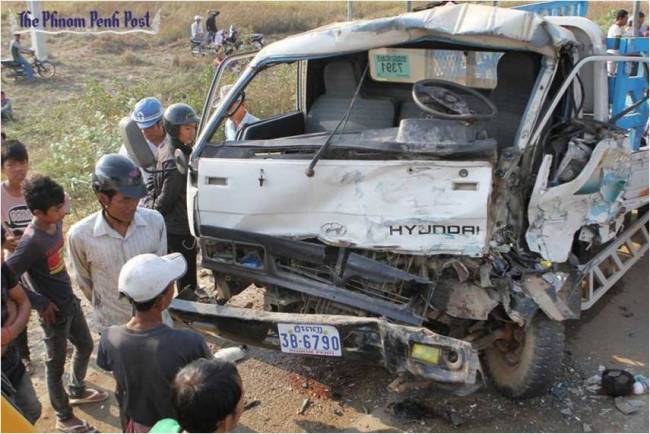The photo above was published in the Phnom Penh Post following a tragic road accident in which the driver of this van was killed. The van itself was carrying more than half a dozen factory workers time, and it is lucky that there were no other losses of life. But look at that photo.To me it encapsulates several reasons why road safety in Cambodia is appalling at best, and showing signs of getting worse due to the rapidly increasing numbers of motor vehicles on the roads. (Today there are more than 1.7 million 4 wheeled light vehicles and around 1.5 million motorbikes and tuktuks.)
There are many reasons why road safety produces such bad statistics for Cambodia. In the year 2012 almost 2000 people died in traffic accidents, a figure that was double that from seven years previous. According to one report from the Voice of America, traffic fatalities in Cambodia account than nine times the number of deaths from malaria, dengue fever, HIV and AIDS put together. On a typical holiday weekend Cambodia can expect to lose between 30 and 50 lives.
Of the deaths, 80% are males and half are aged 15-29 years old.
Here are some of the causes – or issues that need addressing:
- Driver attitudes. This encompasses poor driver training, the notable presence of drunken drivers, as well is the characteristic high speed “get out of my way” stubbornness that seems prevalent on Cambodian roads. By government reckoning, 96% of Cambodia’s road accidents come from human error.
- A second cause for the bad chemistry is the mixed usage of roads by a wide variety of pedestrians, cyclists, motorbikes, cars, heavy trucks – but also by non-transport users including children at play, wandering livestock and the presence of roadside stalls.
- The third cause for the high road toll is the way vehicles are over-utilised. Visitors to Cambodia are always amazed to see entire family’s poised on a motorbike, or to see flatbed trucks populated with no fewer than 40 passengers piled on top of cargo goods. When one of these vehicles has an accident the risks are multiplied.
- A fourth contributor to the high road toll is the compliance with road safety practices such as the wearing of seat belts in cars and trucks, or the wearing of helmets by cyclists and motorcyclists.2012 pedestrians, bicyclists and motorcycle riders accounted for 83% of fatalities. Figures from 2010 suggested that just 65% of motorcyclists were wearing helmets, and only 9% of passengers were wearing helmets. And while there are laws that ban driving while using a handheld mobile phone compliance with this is not consistent.
- The fifth contributor is the poor standard of vehicles themselves. Often these cheap and elderly imports, second-hand from other countries. Compounding this problem is the fact that so many vehicles are so poorly maintained.
- Finally there is only a weak emergency assistance infrastructure with between 11% and 49% of accident victims receiving ambulance attendance.
Is the picture getting worse? It depends on how you look at it. On the one hand the rate of fatalities per million kilometers of travel appears to be dropping slightly thanks to improved roading and the introduction of some basic safety measures. The government is likely to be stricter at enforcing helmet wearing for example.
But in raw terms, the sheer number of deaths, the chart keeps pointing upwards. In 2001 there were just four deaths per hundred thousand people in Cambodia. By 2010 the figure had risen threefold to just over 12 deaths per hundred thousand people.
Of course this has social costs quite apart from the grief when a family member, friend or colleague is killed. A death or injury can easily make the difference between a family making its way versus being destitute.
Road safety specialists from overseas put a cost on traffic fatalities, and in Cambodia they suggest this is costing the country the equivalent of 3.5% of GDP. Put in those terms it is perhaps no surprise that the government is prioritising road safety. It’s initiatives tend to focus on compliance, so Cambodians can expect a police force more vigilant toward helmet usage and possibly random breath testing.
When you look at the list of causes of poor road safety in Cambodia, it is hard not to see that a big underlying reason is poverty. It is poverty that puts 30 or more people on the back of the truck. It is poverty that prevents the owner of that truck from investing sufficiently in the maintenance and upkeep of the truck’s mechanicals. It is not enough to say the rule breakers are the main cause of road fatalities in this developing nation. But perhaps it is a start.
PS. Below. Thank you to sponsor Kim Deane for donating helmets for the senior students supported by Savong. These students navigate the busy roads in Siem Reap.
Road safety irony at work – fancy a Suzuki Smash?



Pingback: How to drive in Cambodia | Adventures in TEFL
Pingback: Arms race in reverse. How CMAC is clearing weapons from Cambodia | Savong School Cambodia